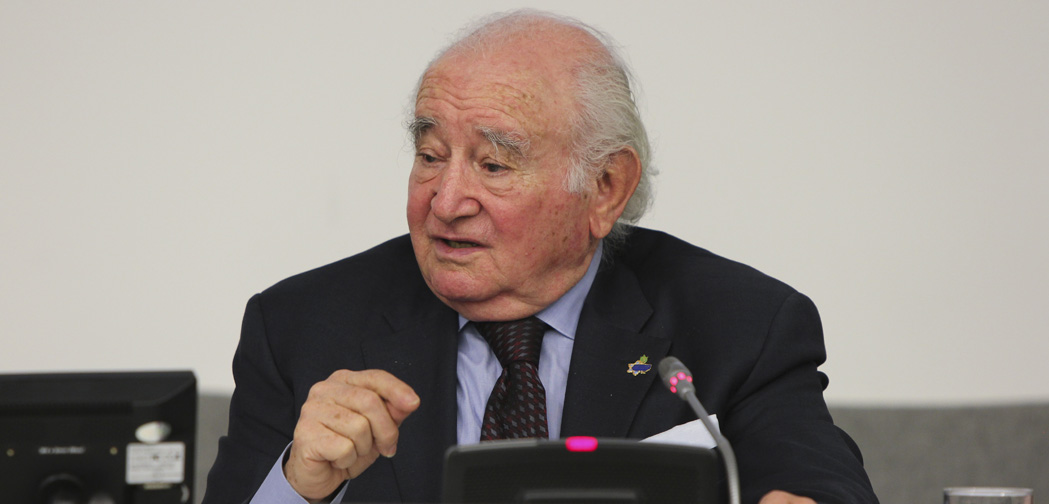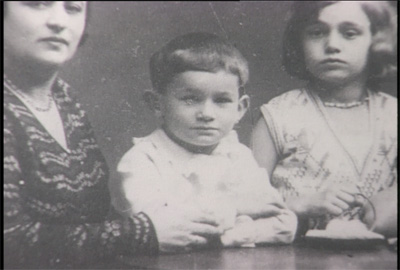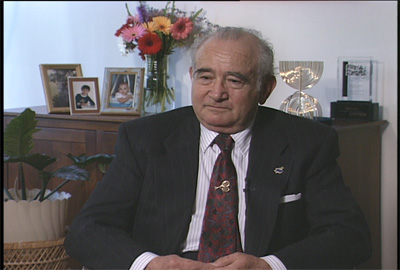Voices from the Visual History Archive: Roman Kent

Born April 18, 1929, Lódz, Poland
Interviewed April 29, 1996, New York, NY

Roman Kent is a highly sought after and influential member of the survivor community. He has for years been on the board of the Claims Conference, is a member of the United States Holocaust Memorial Council, chairman of the American Gathering of Jewish Holocaust Survivors & Their Descendants, and holds many other distinguished positions.
One may wonder then why with such sophisticated insights into the complexity of the Holocaust and its consequences that he chooses in his testimony in the Visual History Archive to focus on one of the simplest of all relationships—his pet. It is because of his dog, Lala, that Kent sometimes wishes people were more like animals.
He and his family, from Lodz, Poland, were hunted and homeless during World War II. They worked at forced labor, were plagued by illness, tormented by hunger, and were abandoned by neighbors. Only Lala seemed to show them complete loyalty and reminded the young boy that there was still love in a world that had gone mad. It is a message that Kent carried with him after the war.
Although her presence in Kent’s life was brief, Lala has become a way to connect with young people learning about the Holocaust. Because it is easier for a child to relate to losing a dog than being separated from his or her family or living in a concentration camp, an activity that focused on Kent and Lala has been the most popular in the Institute’s IWitness program for secondary-school students. Kent also wrote a book, My Dog Lala, in 2008 as a way to reach even more young people.
Before the war broke out, Kent (born Roman Kniker) lived a typical, carefree life in Lodz. The Knikers were fairly rich Kent said in the Visual History Archive testimony he gave in 1996. His father, Emanuel, often treated the boys to horseback riding. Aunts, uncles, and cousins would come to the Kniker house to celebrate Passover, Hanukkah, and the other Jewish holidays, when Kent and his siblings would sing the traditional songs they had learned in school.
The field behind his father’s textile factory hosted the endless games of soccer, basketball, and volleyball, which Kent played with his younger brother Leon and his friends from the Jewish school he attended dutifully six days a week.
His mother, Sonia, stayed home and took care of him, Leon, and their older sisters, Dasza and Renia.
Into this happy world came the perfect addition: a small dog named for the Polish word for doll. Lala quickly became part of the family, and the children doted upon her.
“She was a beautiful dog,” Kent says
The family was at their summer villa in the Polish countryside when war broke out.
It was exciting at first. Since schools had been closed, the Knikers stayed at the villa. When a neighbor alerted them that the Germans were close by, they returned to their apartment in Lodz.
The Knikers were forced to leave so quickly that they decided that Lala would stay with the superintendent of the villa. But while the family was at the train station, Lala appeared. The children were happy, and they took her back to Lodz with them.
Life in their hometown had changed so quickly. Restrictions against Jews were in full effect. The family had to wear Stars of David on their clothes. They were not allowed out at night. Emanuel lost his job as head of the factory.
One day, they found that their apartment had been closed up and taken over by a local German. The Knikers moved into an empty room in their factory. They had nothing, but they still had one another and their dog with them.
But by the end of 1939, all the Jews in the city had been ordered to move into the Lodz ghetto. The Knikers again had to say goodbye to Lala, who had just given birth to a litter. Kent and his siblings were too young to understand what was happening, but they worried about Lala.
Their first night in their new home—one room and a kitchen for the six of them—the Knikers were awakened by scratching at the door.
It was Lala.
 “How she found us, God only knows,” Kent says. “Her golden hair was covered with mud, sleet, and snow. She was tired, but the moment she saw us, she started licking our hands, our faces, her tail was wiggling, and of course we were happy.”
“How she found us, God only knows,” Kent says. “Her golden hair was covered with mud, sleet, and snow. She was tired, but the moment she saw us, she started licking our hands, our faces, her tail was wiggling, and of course we were happy.”
In the morning, Lala left—to return to her puppies at the factory. But each night, she would arrive at the Knikers’ apartment, and each morning she would go back to the factory.
After the puppies were old enough, Lala stayed with family in the ghetto, but shortly thereafter, the Germans gave an order that all dogs must be turned over to them.
“Since all ‘Jewish’ dogs in the ghetto were registered, there was no way for us to avoid this because noncompliance meant death to the owner,” Kent says.
The family was forced to hand over the dog to the authorities. She knew something strange was happening because she trembled and whined, but there was no choice. They never saw their beloved pet again.
Her disappearance serves to highlight for younger students just how bleak life was in the ghetto.
“Slowly the screw tightened,” he says. “It went from bad to worse. From day to day you could see the starvation. You could see the dead and dying in the streets. There weren’t enough people to bury the dead.”
But the young Kent remained defiant. Forced to sew military garments for German soldiers, he and others refused to work quickly. It was, he says, an act of resistance that was a more effective weapon than brandishing a gun.
His father died in 1943 of malnutrition and ulcers. A year later, when the ghetto was liquidated, Kent, his mother and siblings were taken by cattle car to Auschwitz. The first thing he remembered upon his arrival were the deafening sounds of crying and screaming. Once off the train, he witnessed savage murders being committed with chilling nonchalance. Soon, he and his brother were separated from their mother and sisters and sent to a different part of the camp. It was far worse than anything he had seen in the ghetto.
“It was the first time I encountered the vicious brutality,” he says.
Kent explains that it is impossible for those who were not there to begin to imagine the unbelievable, horrific scene.
“If Shakespeare were alive, he wouldn’t be able to describe a day at Auschwitz,” he says. “I don’t think anyone—regardless of how many degrees he has, how many books he studied—can understand the torment of even one hour at Auschwitz.”
Only after their liberation, which came during a forced march from the Flossenberg concentration camp to Dachau in 1945, were the brothers able to reunite with their sisters, Dasza and Renia.
Renia told them that their mother had been sick and been sent to a hospital. Soon thereafter the Germans murdered all of the patients. Dasza was very ill and died in Sweden a few months after liberation.
Kent immigrated to the United States, attended college, and became a successful businessman and leader of many Holocaust-remembrance organizations. He married, had two children, and built a new life. He prospered.
Instead of making him bitter, Kent’s past became a reminder to be kind and helpful to others. He continues to teach children about the beautiful golden-haired dog.
“No barbed wire, no guns stopped this little dog from loving us, coming to us, and then going back to her own children,” he says. “Love is stronger than hate!”
Kent strongly advocates the importance of education, teaching young students the lessons to be learned from the Holocaust. He believes that future generations must be made aware of what transpired during this horrendous occurrence in our history, to help ensure that such an unspeakable event will never happen again. Education is also a valuable tool to accentuate the meaning of tolerance.